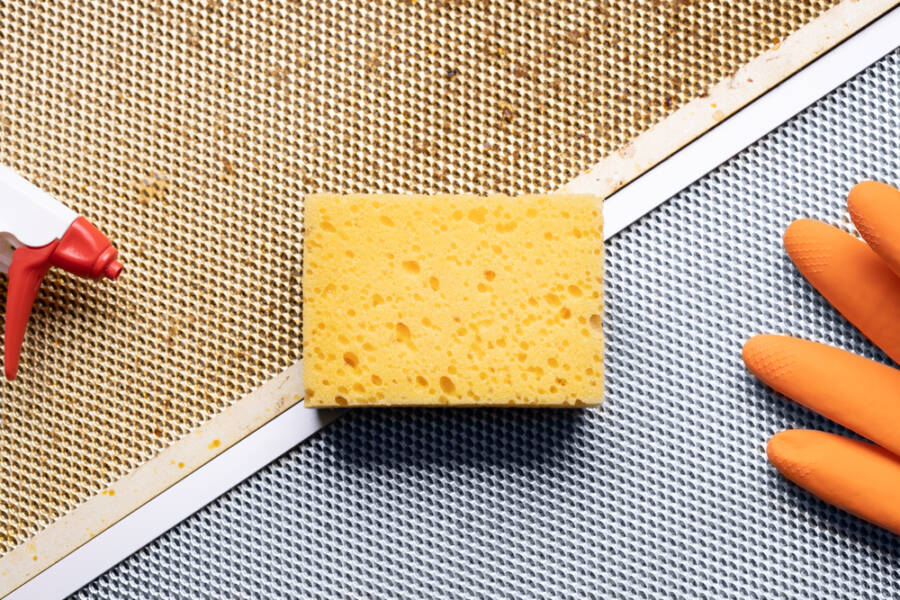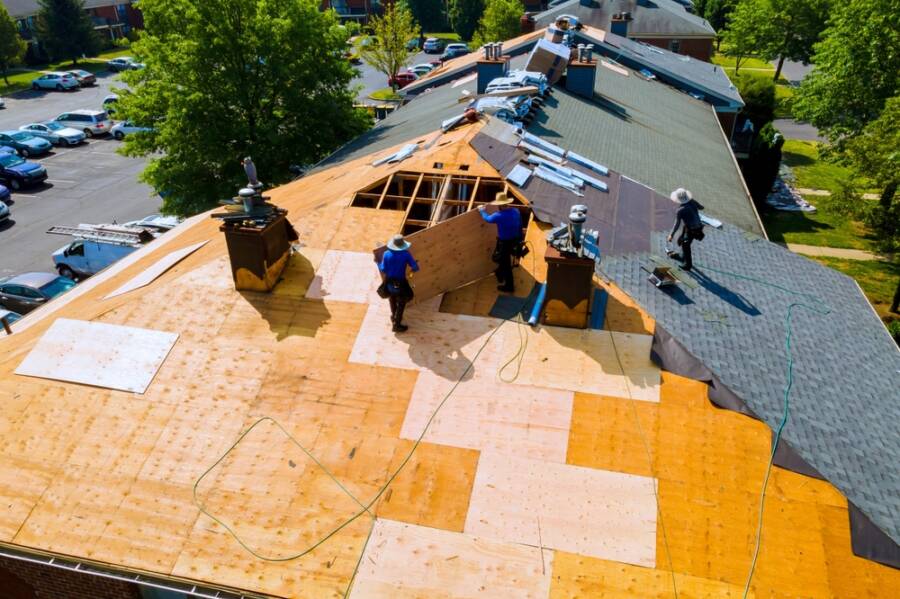Do you love the look of Philodendron birkin but find that it’s just not white enough for your taste?
Don’t worry, you’re not alone. The beautiful variegation on this plant can be hard to come by, and even when you do find a Philodendron birkin with lots of white, it can be difficult to keep it that way.
But there are a few things you can do to encourage more white growth on your plant, and in this post, we’ll go over some of the best tips and tricks.
So if you’re ready to get started, let’s dive in!
How to Get More White Variegation on Philodendron Birkin?
To increase the white variegation on Philodendron birkin. You can propagate the plant by cutting back a stem, giving it the right amount of light, water, and nutrients, keeping it away from extreme temperatures, and giving it a boost with a low-nitrogen fertilizer.
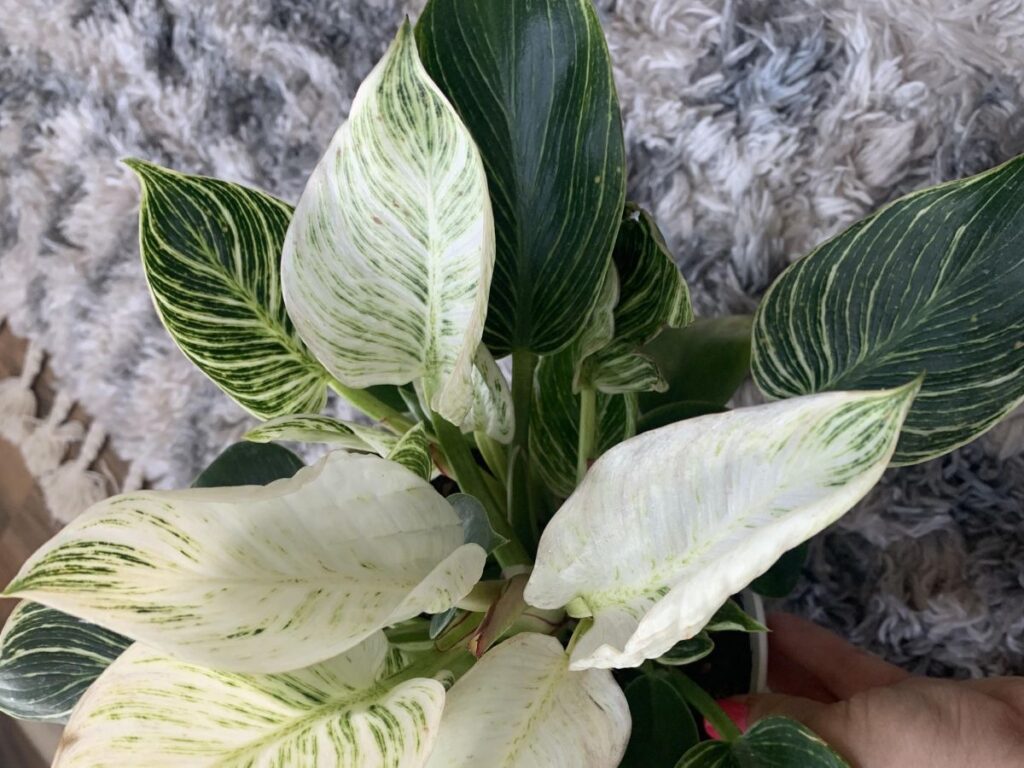
9 Tips to Get More White Variegation on a Philodendron Birkin?
Tip 1: Propagate a variegated stem by cutting
One way to get more white variegation on a Philodendron birkin is to propagate a variegated stem cutting and grow it into a new plant. This new plant will have the same characteristics as the parent plant, including any variegation on the leaves with more white on them.
To propagate a Philodendron birkin stem cutting, follow these steps:
Choose a healthy stem with white variegation on the leaves. Use clean, sharp scissors to cut the stem just below a leaf node, making sure to leave at least two leaves on the cutting.
To encourage root growth, dip the cutting in rooting hormone.
Plant the cutting in a well-draining potting mix, making sure to bury the leaf node.
Water the soil and place the cutting in a warm, bright location out of direct sunlight.
Keep the soil moist and provide regular fertilization to help the cutting grow into a new plant.
With proper care, the cutting should take root and grow into a new Philodendron birkin with more white variegation on its leaves. This is a great way to create more of these beautiful plants and add more white to your collection.
Tip 2: Pot the cutting in the right potting mix
It is important to use the right potting mix when trying to get more white variegation on a Philodendron birkin because the soil must be rich in nutrients and have good drainage. Poor soil quality can cause root systems to become waterlogged, resulting in root rot and other problems.
Additionally, a proper potting mix will provide optimal conditions for growth, allowing the plant to use its energy more efficiently for leaf variegation.
Tip 3: Provide the Philodendron birkin with plenty of indirect sunlight
It is important to move the Philodendron birkin to a brighter area because it needs bright indirect light to thrive and produce white variegation. Avoid placing the plant in direct sunlight, as this can cause the leaves to burn and fade.
Without enough bright indirect light, it will start to lose its variegated leaves and die. So, to make sure the Philodendron birkin gets enough bright indirect light, put it near a window that gets indirect sunlight or near an indoor window that is covered with curtains or tinted.
Tip 4: Avoid over-watering and stick to a watering schedule
It’s important to water your Philodendron birkin plant regularly, but be careful not to over-water it. Too much water can cause the leaves to yellow and can lead to root rot, which can affect the plant’s ability to produce white variegation.
If the topsoil is dry, then it needs water, so watering the plant once a week can help encourage new growth and promote drainage.
To avoid over-watering, allow the soil to dry out slightly between waterings, and always check the soil moisture level before watering. Here are a few methods to check the soil moisture level:
- Use a moisture meter. This is a simple tool that you can insert into the soil to measure the moisture level. Most moisture meters have a scale with a range of dry to wet, so you can easily determine whether the soil is too dry or too moist.
- Stick your finger into the soil. This is a simple and inexpensive way to check the soil moisture level. Insert your finger into the soil up to the first knuckle, and then check the moisture level by touching the soil. If the soil feels dry and crumbly, it’s time to water the plant. If the soil feels moist or wet, it’s best to wait a few days before watering again.
By following this routine, you can make sure that your philodendron gets enough water and nutrients to help it get white stripes.
Tip 5: Ensure consistent temperature
Temperature can have a significant effect on the variegation of a Philodendron birkin. It is important to maintain an ideal temperature range of 65 to 75 degrees Fahrenheit (18°C – 24°C) in order to prevent shock, which can lead to variegation loss.
If the temperature falls below or rises above the mentioned range, color production may not be completed properly, and the plant may revert back to its original color.
The best temperature for Philodendron birkin plants is between 55.5°F – 86°F, avoiding either extreme range in order to keep it from losing its white variegation.
Philodendron birkin plants prefer a consistent, warm temperature, so try to keep the plant away from drafty windows or air conditioning vents. Don’t put the plant in places where the temperature changes a lot, as this can stress the plant and stop it from making white stripes.
Tip 6: Use a low-level nitrogen fertilizer
A low-nitrogen fertilizer is a good way to get more white variegation in a Philodendron birkin because it helps control chlorophyll production while keeping the leaves with white and green stripes. This also helps to improve the white variegation on the plant’s green leaves.
Balanced houseplant liquid fertilizers can also be used for this purpose.
Use a balanced fertilizer and follow the label’s instructions for how much and how often to apply it.
Tip 7: Understand the growth habit and pruning
The growth habit and pruning of a Philodendron birkin can influence the amount of white variegation on the plant, but it is not a guarantee. It’s important to know how a Philodendron birkin grows and how to prune it so that it keeps doing well and keeps making healthy, colorful leaves.
Pruning should be limited and only used to get rid of dead or damaged leaves.
Tip 8: Ensure sufficient sunlight
Sufficient sunlight is necessary to get more white variegation on a Philodendron birkin. Without enough light, the plant may experience reversion, where it loses its vibrant color and variegation.
To avoid this, it should be placed at least 3 to 5 feet away from a window to ensure that there is an adequate amount of bright light for the plant without risking sunburn or overexposure. Using artificial grow lights can also supplement natural lighting during the winter months or other times when daylight is limited.
Tip 9: Maintain humidity levels
Maintaining humidity levels is important in order to get more white variegation on a Philodendron birkin. High levels of humidity are needed for the white variegation to appear and stay. Low temperatures and prolonged dry periods can inhibit the plant’s functions, reducing the amount of white variegation visible.
To keep humidity levels high, one can use a humidifier, place it in a naturally humid room, or group plants together. The misting only keeps water droplets around the local area for 30–60 seconds before dispersing into the rest of the room.
Wherever you live and whatever climate you have, there are ways to maintain moisture levels, from leaving philodendrons outdoors in tropical climates to constructing DIY humidity chambers for dry climates.
What Are the Factors that Affect How Much White Variegation a Plant Can Have?
There are several factors that can affect the amount of white variegation on a Philodendron birkin plant. These include the plant’s genetics, the amount of sunlight it receives, and the overall health of the plant. Additionally, the age of the plant can also play a role in how much white variegation it has.
How to Identify and Troubleshoot Common Issues Related to Getting More White Variegation on a Philodendron Birkin?
White variegation on a Philodendron birkin is a desirable trait because it can add visual interest to the plant. Identifying common issues that may prevent the plant from developing more white variegation can help you troubleshoot any problems they may be experiencing and take steps to encourage the development of more white variegation.
Here are some steps you can take to figure out why your Philodendron birkin doesn’t have as much white on it and how to fix it:
Check the plant’s genetics: Some Philodendron birkin plants are genetically predisposed to have more white variegation than others. If your plant is not showing a lot of white variegation, it may be because it has genes that produce less of this characteristic.
In this case, there may not be much you can do to increase the amount of white variegation on your plant.
Monitor the plant’s exposure to sunlight: Philodendron birkin plants need plenty of bright, indirect light to thrive. However, too much direct sunlight can cause the leaves to fade and lose their variegation.
Make sure your plant is getting enough light, but not too much, to promote healthy growth and maximize the amount of white variegation on the leaves.
Keep the plant healthy: A healthy Philodendron birkin plant is more likely to have vibrant white variegation on its leaves.
Make sure the plant is getting the right amount of water, fertilizer, and other care to keep it healthy and thriving.
Consider the plant’s age: As a Philodendron birkin plant grows and matures, it may develop more white variegation on its leaves. If your plant is young and not yet showing a lot of white variegation, it may simply need more time to develop this characteristic.
What Is the Philodendron Birkin Variegation?
The variegation on the leaves of a Philodendron birkin is caused by a genetic mutation that produces a lack of chlorophyll, the pigment that gives plants their green color. This mutation results in the white stripes on the leaves, which vary in size and pattern and are never the same.
The variegation on a Philodendron birkin is not always consistent, and the plant may produce leaves with varying amounts of white and green. Some leaves may be more white, while others may be more green. This is normal and does not indicate that the plant is unhealthy.
This type of plant, also known as a Philodendron White Knight, is prized for its unique variegation, which is the term used to describe the white stripes on its leaves.
Philodendron birkin variegation is a very popular plant among both gardeners and horticulturists because it has a unique look.
Is Philodendron Birkin Variegated?
Philodendron birkin plants are variegated. The leaves of Philodendron birkin plants have heart-shaped features and delicate yellowish-white to white pinstripes. The amount of variegation on the leaves can change from leaf to leaf, making each Philodendron birkin plant unique.
The variegation on a Philodendron birkin is determined by the plant’s genetics, so it is not possible to control or predict the exact pattern of variegation on a particular plant.
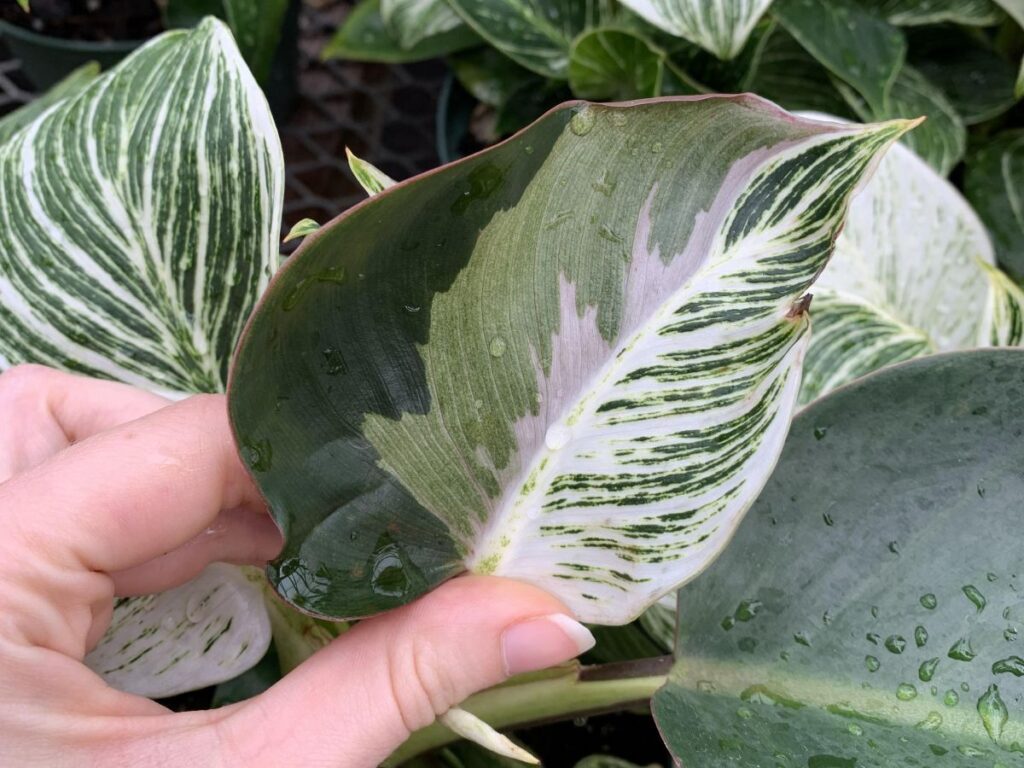
Philodendron Birkin Rare Leaf Variegation
Philodendron birkin is a relatively new cultivar that was only recently introduced to the market. Because of its unique appearance, it is considered a rare and sought-after plant by many collectors. However, it’s impossible to confirm whether it is rare in terms of its leaf variegation specifically.
Philodendron birkin Leaf Colors
Philodendron birkin plants typically have dark green leaves with white or cream-colored stripes running along the veins. The exact color and pattern of the leaves can vary somewhat, depending on the specific plant and growing conditions.
Some plants may have more pronounced stripes, while others may have more solid-colored leaves. In general, however, the leaves of Philodendron birkin plants are dark green with white or cream-colored stripes.
Can a Philodendron Birkin Revert?
It has been observed that a Philodendron birkin can revert back to its solid green color. This process is called “reversion,” and it occurs when the plant’s genetic makeup changes, causing it to lose the variegated coloration that makes it so distinctive.
Reversion is a natural process that can happen to any plant, but it is more common in certain species, including the Philodendron birkin.
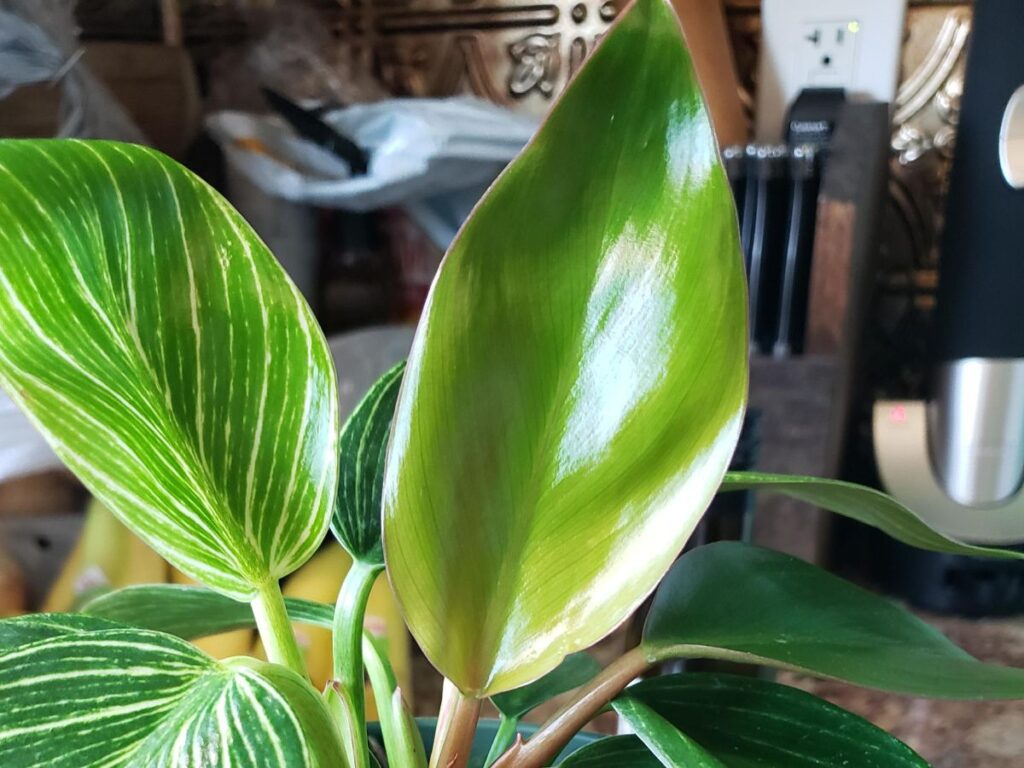
What Causes Philodendron Birkins to Revert?
There are several reasons why a Philodendron birkin might revert to its solid green color. One of the most common causes is improper care or exposure to unfavorable growing conditions.
For example, if the plant is not getting enough light or is not being watered regularly, it may begin to lose its variegated coloration and revert to its solid green form.
Another reason for reversion is the plant’s genetics. Some Philodendron birkin plants are more prone to reversion than others, due to their genetic makeup. This means that even if you provide the plant with optimal growing conditions, it may still revert to its solid green color over time.
How to Prevent Fading or Reversion of Philodendron Birkin Variegation?
In order to prevent the Philodendron birkin variegation from fading or reverting, it is important to provide the plant with plenty of bright indirect sunlight.
The plant should also be watered regularly, but not overwatered, fertilized monthly during its active growing season, repotted when it outgrows its current pot, and pruned of any damaged or decaying leaves.
You should also avoid exposing the plant to extreme temperatures or drafts, as these can also cause it to revert.
What Should You Do If Your Philodendron Birkin Plant Loses Variegation (Philodendron Birkin Plant Reverts to Its Original Variegation)?
If your Philodendron birkin loses its variegation, there are a few steps you can take to try and bring it back.
First, make sure that the plant is getting enough light. As was already said, Philodendron birkin plants need bright, indirect light in order to maintain their variegation.
Next, check the plant’s watering schedule. Overwatering can cause a Philodendron birkin to lose its variegation, so make sure that the soil is allowed to dry out slightly between waterings. Allow the top few inches of soil to dry out before watering the plant again.
If the plant is still losing its variegation despite proper lighting and watering, it may be due to stress or disease. Try moving the plant to a new location with brighter light and better air circulation, and check for signs of pests or disease. If necessary, you can treat the plant with a suitable pesticide or fungicide according to the manufacturer’s instructions.
It’s also worth noting that variegation in plants can be unstable and may naturally fade over time. In some cases, a Philodendron birkin may lose its variegation even with proper care. If this happens, you can try propagating the plant by taking stem cuttings and rooting them in soil. The new plants should have the same variegation as the parent plant.
Conclusion
With the right care, you can have a Philodendron birkin with beautiful white leaves. Be sure to follow the tips in this guide, and you’ll be on your way to success. Thanks for reading, and good luck!
Philodendron birkin variegation is a beautiful thing, but it can be difficult to achieve and maintain. Luckily, there are a few things you can do to encourage more white growth on your plant. By following the tips and tricks in this post, you’ll be well on your way to getting the Philodendron birkin of your dreams.



